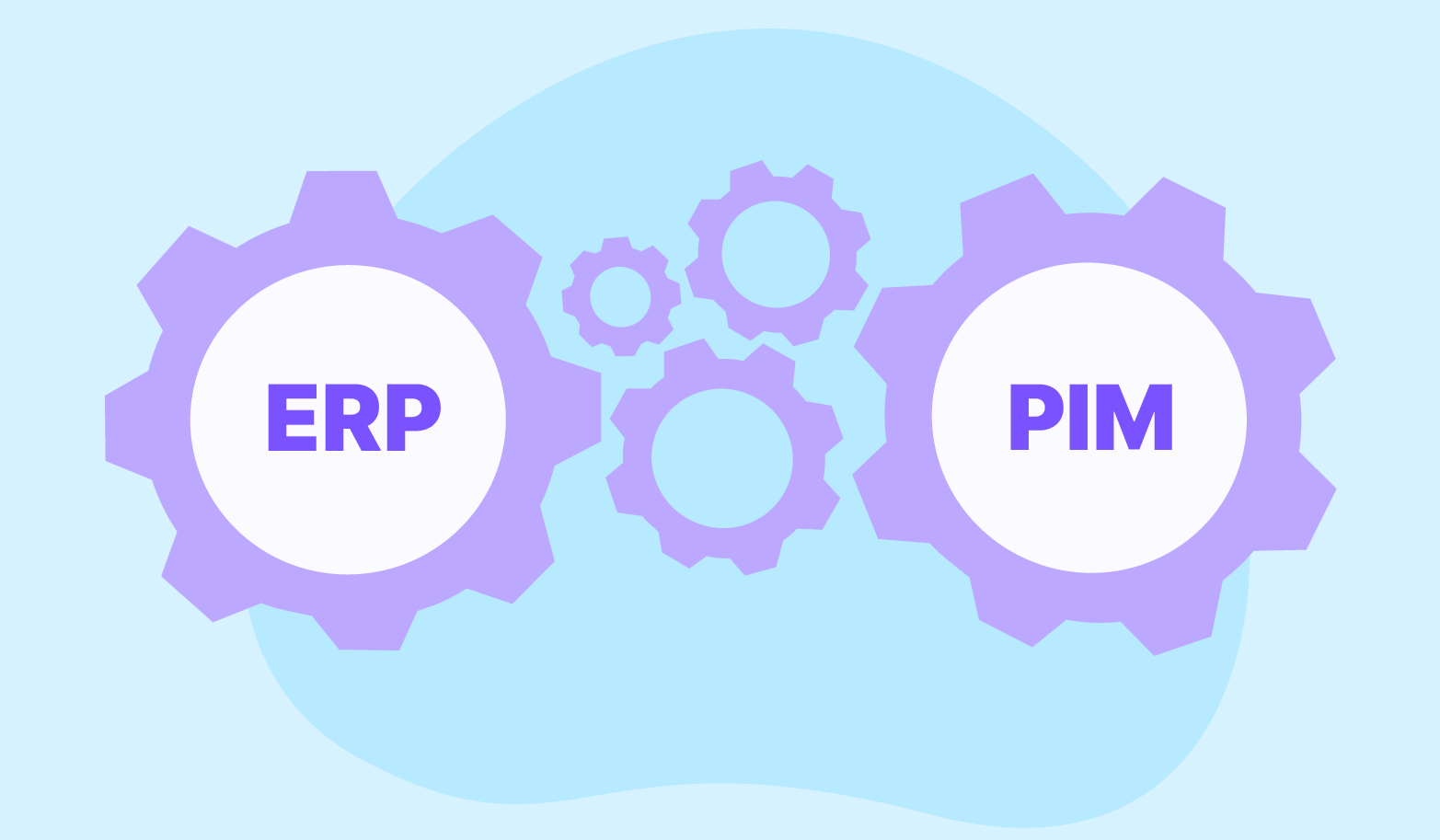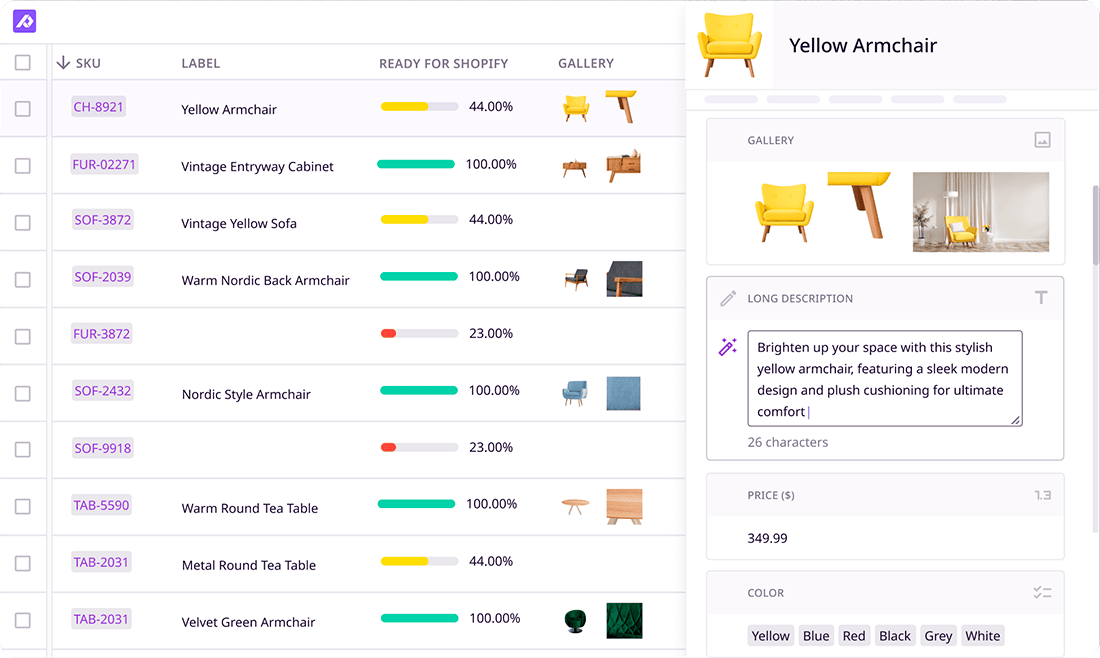
Keep the good stuff coming
Subscribe to our blog newsletter and get monthly content that helps you manage product data smarter.
No spam. Just real value.
If you're on the lookout for an ecommerce automation tool, you've probably run into a variety of solutions. Two of the most popular options—PIM and ERP—can easily automate your core business processes.
The real question is, are they the same, or are they different? And perhaps most importantly, how do you choose the right one for your business?
The truth is that ERP and PIM systems both have a place in an ecommerce tech stack.
Let's take a look at everything you should know about PIM vs ERP (or you can hop to the section that interests you most)
A (very) quick history of PIM and ERP systems
The idea of ERP began as early as the 1960s when a manufacturer named J.I. Case developed a materials resource planning tool (MRP). The goal was to more easily manage product production runs by constructing a rudimentary 'automation' for procurement and delivery.
The 1980s saw the development of MRP II, which was the second, more complex iteration of the original MRP. This quickly caught the attention of non-manufacturing businesses. By the early 1990s, the 'modern' version of ERP was born.
There have been all sorts of ERP developments since the 1990s:
- 1998: Cloud ERPs provide access from anywhere
- 2000: ERPs could link with other systems (including PIM platforms)
- 2010: ERPs connect with IoT and machine learning tools
PIM systems also got their start in the late 90s, as they offered a level of customization that enterprise resource planning (ERP) tools couldn't provide. This quickly changed by the early 2000s when integrating PIM with ERP became trivially easy.
Today, companies can purchase a single ERP that connects with numerous information points (aka their other software with unique capabilities). This creates a seamless flow between multiple products for business management, including CRMs, customer experience platforms, and of course, product information management systems.
What is PIM and ERP?
Although they seem similar on paper, PIM and ERP systems accomplish very different tasks.
What is an ERP?
An ERP system (or enterprise resource planning tool) is a platform that acts as a central hub for key business departments. For example, your ERP might connect your tools for financial reporting, inventory management, supply chain supervision, and other systems in your tech stack.
You can use ERP solutions to create a centralized database for your business operations - from inventory and accounting to human resources and supply chain management. This means you can use it to host data like:
- Vendor and supplier information
- Employee data and HR records
- Financial data (payroll, invoices, accounting)
- Inventory levels and stock management
- Order processing information
- Supply chain data
- Purchase orders and procurement
What is PIM?
A PIM system, also known as a product information management system, is specialized software specifically designed to manage and organize product information. Unlike an ERP, it only focuses on your products (and not financial, recruiting, or other arms of your business).
The product information organized in your PIM can easily be pushed to your existing sales channels. This includes:
- SKUs
- Product names and description
- Product attributes
- Technical specs
- Pictures and videos
- Marketing materials (like Amazon descriptions)
- Marketing materials (like Amazon descriptions)
So to recap, an ERP can handle inventory management, stock levels, product availability, and similar things. However, it's not as robust as a dedicated PIM, and doesn’t keep tabs on rich media, SKUs, or marketing materials.
That's why most people prefer to connect their PIM platform to their ERP: so they can keep all their data in the same central hub.
PIM vs other management systems
A PIM tool isn't the only way to manage product metadata for your business. There are a few other management systems to keep in mind:
- DAM: Stands for digital asset management system. A DAM is primarily a marketing tool that tracks brand assets such as graphics, logos, and other rich media.
- CMS: Stands for content management system. CMS allows you to manage pictures, graphics, blog posts, and more – not just your product information.
- MDM: Stands for master data management. While PIM systems drill down into specific product information, MDM is more concerned with the operational and analytical needs of a business.
- CRM: Stands for customer relationship management software. Unlike PIM, a CRM is designed to track customer data (and not product data).
- PXM: Product experience management is a front-facing, client-focused product management hub. Compared to PIM, PXM doesn’t offer all the nitty-gritty details your product management team needs.
Of course, a PIM can't take the place of these systems, so you should evaluate which modules and options make the best sense for your business.
We don’t have enough time to cover all that here, but it might be worth exploring as your business expands.
For now, let's take a step back and get a bird's eye view:
Uses for PIM vs ERP
You can use a PIM solution to keep a close eye on product information. With an ERP, you can store product data and connect to the rest of your tech stack, whether it’s for your finance office or your HR department
Let’s take a closer look at all the things you can do with an ERP and PIM:
Uses for ERP
Here are some real-life use cases for an ERP system:
Manage your finances
If you’ve got money on your mind, your ERP can help. You can connect this ‘central hub’ to all the financial tools you’re already using, including ones for:
- Taxes, bookkeeping, and accounting
- Invoices and payments
- Reporting and analytics
- Budgets and expenditures
- And beyond
Track inventory in your supply chain
This way, everyone with the right credentials can tap into the right folders of business information (which means nobody gets left in the dark).
Perform order management
Purchase orders (POs) and fulfillment tracking and returns shipping, oh my! An ERP makes life a little easier by connecting all these functions in a single ‘center square.’ They can also help you set up automations and triggers so you spend less time struggling through redundant tasks.
Put HR on autopilot
Keep an eye on your human resources and seamlessly funnel new folks through your recruitment process. Since everything is integrated into a consistent user interface, you don't need to worry about hunting for numbers or context.
Keep up with business intelligence
Reporting and analytics and forecasting, oh my! It’s a lot to keep an eye on — but you’ll need all of them if you want to keep your business competitive. The good news is, an ERP can help you do this quickly. It’s easy to connect your tools into a central hub, like:
- Performance metrics
- Custom reports
- Real-time dashboards
- KPI tracking
- And beyond
Uses for PIM
PIM systems are also incredibly effective at managing product data.
With the right PIM system by your side, you can:
Make a single source of truth for your products
No more hunting aimlessly for that product description, or searching your Dropbox folder for images. With a PM system, you can keep all things product-related in the same, accessible folder. And since it’s stored in the cloud, you can access it from anywhere.
Manage digital assets and product descriptions (easily!)
Speaking of images and product descriptions, you can use your PIM to store important product details. Now, PIM is not DAM, but any system worth its salt should have DAM functionality.
Need to update a product image, or tweak the language in your description(s)? Just hop into your PIM and make the right edits in seconds.
Push product information across all the places you sell
It’s easy to sync product info on practically every sales platform you’re on, whether that’s Wix, Facebook, Google Shopping, or someplace in between (which might also be connected with your ERP system). This limits the amount of time you'll spend hopping between multiple tabs or managing information on your own.
Keep consistent product information everywhere you go
With a PIM, you can easily sync updated product data across platforms so they’re always as accurate as possible. You might also have support for channel-specific content management so you can store the right descriptions, photos, and videos (just in case).
Streamline product content workflows with your team
PIM is specifically designed to share information with your team. You’ll have built-in capabilities to crush and automate routine tasks with:
- Cloud-based product access
- Version histories and access control
- Collaborative product data editing
- Role-based user permissions
- Real-time product updates for all team members
- Version control and change tracking
Create sales materials and digital catalogs
The right PIM software can help you create sales assets and catalogs so you can adjust critical details at the drop of a hat. For example, it’s easy to create digital ecatalogs that are perfectly curated to customer needs. You can also share your products in online brand portals with a fancy, white-label feel.
Key differences between PIM and ERP
First, let's make sure we're on the same page.
Both ERP and PIM systems enable companies to manage their operations more effectively.
The difference has everything to do with their specificity. ERPs were designed to manage all core business functions. PIM systems go deep into just one function (product information management).
Here's a closer look:
What can ERP do that PIM does better?
To recap, the purpose of ERP is to handle business processes, so its primary uses are in finance, operations, and logistics.
This means you’re primarily juggling operational data, which includes quantities, costs, transactions, and more.
So while an ERP can track inventory and product orders, you'll need a PIM to manage higher-level tasks such as:
- Product content syndication and distribution
- Simplified channel integrations (like Amazon and Facebook)
- The ability to manage rich product data from anywhere
- The power to create and update product catalogs easily
What can PIM do that ERP does better?
The purpose of PIM is to manage product content and enrich information with images or descriptions. Only select members of your team — think your folks in marketing, ecommerce, and sales — will need access to the platform to add or update marketing and technical product content.
In other words: anything non-product related is probably best for a general ERP.
This is especially true if you need to:
- Track financial information
- Improve your recruitment process
- Connect multiple ‘modules’ for your business
- Monitor business analytics and reporting
- Process customer orders and shipping
If you're curious to learn more, check out our guide on why enrich your ERP data with a PIM system.
The benefits of having a PIM/ERP system
A whopping 40% of global businesses don't yet have an ERP system. This, in our opinion, is a real shame—because whether you pick up a PIM or partner with ERP solutions, you can reap the benefits rather quickly.
So what are these benefits, you may ask?
Let's start with what ERP enables companies to do:
The benefits of ERP
- Streamline your business operations. From accounting to inventory, ERP helps manage your core business processes. Plus, there are fewer opportunities for human error, which gives you a higher likelihood of maintaining quality data.
- Financial tracking. Never feel in the dark about your income and expenses again. ERP can help you keep tabs on everything from purchase orders to payroll and everything in between.
- Easily perform inventory management. If you can store all your inventory data in the same place, it becomes much easier to track stock levels, monitor orders, and manage supply chain data.
- Move into better resource planning. A whopping one in five businesses still use spreadsheets to communicate internally and manage daily tasks. But adopting an ERP can help you manage your company's people, time, and money more efficiently, which ultimately leads to serious financial gains.
So what happens if you use a PIM for your business?
Keep your eyes peeled for a similar set of benefits:
The benefits of PIM
- Get organized, effortlessly. It's (traditionally) stressful to track down product assets quickly, including product images, videos, and documents. But with a solid PIM system, you can get and stay organized no matter how big your business grows.
- Collaborate with your team. Silos in product data are like weeds in your garden: you need to be really intentional if you don't want them to show up. The good news is that a PIM can help you keep everyone on the same page. Everyone can have access to the latest product data — no more confusing spreadsheets!
- Level up the customer experience. With a PIM, you can provide accurate, consistent product information across all your sales channels. Customers will have a better experience as a result (and might tell their friends about you too).
- Slash your time to market. It doesn't matter what your business sells today — there's a good chance it'll sell something different in the future. The right PIM can help you quickly launch new products up to 400% faster simply by automating manual tasks.
- Sell across all your channels. Multichannel selling is a breeze with PIM. With the right tool, you can share product data with all your sales channels — no matter how many — in just a few clicks.
- Keep excellent product data. Imagine how effortless it gets to be when maintaining high-quality product information in a single, accessible tool. That’s a bazillion fewer headaches to worry about — and your product team and customers will thank you.
Choosing the right solution for your business: get a PIM, ERP, or both?
Let’s think of your business as a kitchen for a second. In this context, ERP would be like your all-purpose food processor — it chops, blends, and does a bunch of other general tasks.
That means PIM is like your professional stand mixer with specialty attachments — it's built specifically for certain tasks and does them exceptionally well.
Depending on what you're cooking, you might need one or the other.
But the good news is that you can also have both!
With a PIM ERP integration, you can seamlessly connect to both of these solutions and then plug into the other tools you're already using.
How ERP and PIM work together to support core business processes
Combining PIM and ERP is the easiest way to take your business to the next level.
That's not just opinion: it's plain ol' facts.
Just check out some examples from our ebook on PIM and ERP:
- Keep your data flowing smoothly. While your ERP handles inventory and pricing, your PIM enriches with marketing descriptions, high-quality images, and technical specs.
- No more double work! You can update core product data in your ERP, then let your PIM automatically sync and enhance it for your sales channels.
- Heaps more accuracy. When core business systems talk to each other, there's less manual data entry (and therefore fewer mistakes).
- Launch even faster. As you're using your ERP to manage stock levels and orders, you can use your PIM to get product content ready for sales channels.
Of course, while all this looks theoretically great on paper, it's a totally different ballgame when you can see it 'real-lifed.'
So what can a PIM/ERP integration really do?
Let's dive into a real-life case study.
Case study of Plytix PIM’s ERP integration
Safety First Aid is the UK’s largest first aid manufacturer, so as you might imagine, product information management wasn't easy. The team already had access to spreadsheets and a central ERP, but with hundreds of SKUs to manage, they needed something stronger to manage the data flow.
This led SFA to investigate Plytix, an integrated software platform offering a PIM and DAM. It's also designed to connect with your existing ERP system, which allows you to create a single database containing all the product information you need.
Within 12 months of integrating with Plytix, SFA was able to accomplish multiple goals:
- They saved thousands of dollars by shortening their tech stack
- They kept consistent website traffic while boosting their SEO
- They have more control over their content and can easily optimize for better performance
It’s not PIM vs ERP: It’s PIM and ERP!
An ERP system is a powerful way to automate business processes, but when you toss a PIM into the mix, it's practically effortless to automate your product data management.
Using them separately has its benefits for sure. But combining the two is where the rubber meets the road. If you’re ready to get organized, launch faster, and streamline business operations, it’s time to invest in ERP and PIM for your business.
Of course, there are thousands of different PIMs on the market, and picking the perfect option could take some time.
Curious about exploring your options?

What if your product data actually worked for you?
We’ll show you how Plytix helps you stop fixing data—and start using it.
Related posts
Keep the good stuff coming
Subscribe to our blog newsletter and get monthly content that helps you manage product data smarter.
No spam. Just real value.





Think others should see this?
Go ahead and share it.